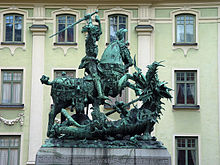Battle of the Brunkeberg
The Battle of Brunkeberg was the decisive battle during the Danish-Swedish War . It took place on 10. October 1471 between the armies of the Swedish Regent Sten Sture the Elder and the Danish King Christian I take. The fighting took place in the area around the hill Brunkebergsåsen in what is now Stockholm 's Norrmalm district.
Course of the battle
The Danish king had traveled to Stockholm with his ships and anchored off today's island of Djurgården (then Valmundsön ) in August 1471 . He went ashore with his army and set up camp north of the city, which at that time consisted only of today's old town and Riddarholmen . The aim of the stay was to depose Sten Sture as imperial administrator and to be confirmed as King of Sweden himself. Above all, Sten Sture's close ties to the German Hanseatic League were displeasing to the regent of the Kalmar Union , with some Swedish councilors from the Wasa and Oxenstierna clans speaking out against Sten Sture's greater power.
On the morning of the day of the fight, Sten Sture reached the area of today's Hötorget square with knights and foot soldiers . He planned an attack from several sides and had allies in the east and south of Brunkebergsåsen with his relative Nils Sture and the lord of the Stockholm castle Knut Posse. He had positioned his own unit west of it. Christian's units had positioned themselves behind wooden palisades on Brunkebergsåsen and set up outposts near the Klara monastery and on the bridge to Blasieholmen. The fighting began violently with several volleys of fire in which the Danish king was hit by a bullet in the face. Christian lost some teeth and withdrew.
When Sten Sture's allies intervened in battle, Christian's army was divided and suffered heavy losses. Many Danes tried to reach their ships, but the bridges between them had previously been destroyed by the Swedes. The number of dead and injured in this battle is unknown.
aftermath
The victory in the Battle of Brunkeberg earned Sten Sture great respect among his compatriots. Some wanted to declare him holy. The sculptor Bernt Notke created the statue of St. George and the dragon as an allegory of the battle. Sten Sture is portrayed as Saint George , who frees the Virgin Sweden from the clutches of the Danish dragon .
rating
Older national romantic sources from Sweden described the battle as a milestone on the way to Swedish independence, but from today's perspective, power-political and economic interests were more decisive. This is particularly evident from the fact that mostly Swedish soldiers took part on both sides. The battle ended in a victory for Sten Sture, who cemented his position for another 25 years.
literature
- Gunnar Åselius: Brunkeberg 1471 - För Sverige eller S: t Göran? . In: Svenska slagfalt . Wahlström & Widstrand, Stockholm 2003, ISBN 91-46-20225-0 , pp. 26–32.

